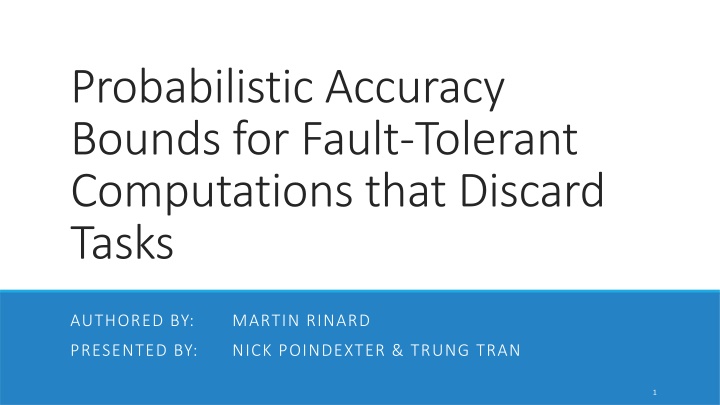
Probabilistic Accuracy Bounds for Fault-Tolerant Computations
Explore a novel approach utilizing task decomposition to handle errors in computations, enabling survival through faults while providing distortion bounds on output. This method utilizes a metalanguage to partition tasks and discard faulty ones, ensuring accurate results despite errors. Discover how this technique can tolerate hardware faults and intentionally omit complex software code to optimize computation time and resources.
Download Presentation

Please find below an Image/Link to download the presentation.
The content on the website is provided AS IS for your information and personal use only. It may not be sold, licensed, or shared on other websites without obtaining consent from the author. If you encounter any issues during the download, it is possible that the publisher has removed the file from their server.
You are allowed to download the files provided on this website for personal or commercial use, subject to the condition that they are used lawfully. All files are the property of their respective owners.
The content on the website is provided AS IS for your information and personal use only. It may not be sold, licensed, or shared on other websites without obtaining consent from the author.
E N D
Presentation Transcript
Probabilistic Accuracy Bounds for Fault-Tolerant Computations that Discard Tasks AUTHORED BY: MARTIN RINARD PRESENTED BY: NICK POINDEXTER & TRUNG TRAN 1
Context/Background Standard program execution platforms would deny uses access to outputs if an error propagated and caused the whole computation to fail New approach to handle errors: Developer starts with standard programming language such as C or Java Use metalanguage (Jade metalanguage) to partition the computation into tasks Discard task when it encounters a software or hardware fault Completes computation by running remaining tasks New technique for enabling computations to survive errors and faults while providing bounds on resulting output distortion 2
Approach 1. Task Decomposition: Use metalanguage to identify task blocks 2. Baseline: Obtain inputs for program to generate correct results 3. Critical Testing Configure execution to randomly fail execution of selected task block at target failure rates Mark task blocks as critical or failable 4. Distortion Model Record observed failure rates and the resulting output distortion 5. Timing Model Each trial records the execution time of program 3
Potential Uses Hardware Faults Tolerating partial failures within a distributed computing platform hosting a distributed (and potentially parallel) execution of the program Software Errors consciously exploit the technique by purposefully omitting complex code otherwise required to handle rare special cases Reducing Computation Time and Resources Optimally fail tasks to obtain maximum execution time while minimizing resulting output distortion output Assumptions and Fault Model 4
Methodology Only programs that produce output of the form O1, , Oi where Oi is a number d is the distortion, measures accuracy of observed result closer the d is to zero, the less the failures distorts the output wi is set of weights to generalize distortion whose outputs are not equally important 5
Methodology Cont. Experimental testing to differentiate between critical and failable task blocks Some blocks must always execute without failures to produce acceptable results Characterize effect that failable blocks have on the acceptability of outputs Script to run execution of program with test input and pseudo-random number generator to select target failure rates Collected data and computed the distortion and timing models 6
Methodology Cont. DISTORTION MODEL TIMING MODEL Used multiple linear regression to compute a linear least-squared distortion model Observed running times of execution to capture effect of failures on running time Produces F value that assesses how well the model predicts the data Useful for calculating time/accuracy trade-offs Obtains scaled time observation (s = t2/t) for each execution to compare R2 value that indicates how much variation in the data the model accounts for Purposefully fails task to move the execution towards a more desirable point in trade-off space Produce confidence interval for specific failure rate space 95% confidence interval 7
Using the Distortion Model Allow user to obtain estimate of how failures affected the accuracy of the results Take observed failure rates and apply distortion model to obtain an estimated distortion along with its associated confidence interval Distortion: Examine model coefficients, the smaller the coefficients, the less the results are affected by failures of the corresponding task block Bounds: Both the distortion estimate and the upper confidence interval must be small enough to make the likelihood that an unacceptably large actual distortion has occurred remote enough for the user to accept Predictive Power: Separated learning inputs and unseen inputs to train and test derived models 8
Experimental Results: Water Water evaluates forces and potentials in a system of water molecules in the liquid state 9
Experimental Results: Search Search is a program from the Stanford Electrical Engineering department that uses Monte-Carlo technique to simulate the elastic scattering of each electron from electron beam into solid 10
Experimental Results: String String uses seismic travel-time inversion to construct a two-dimensional discrete velocity model of the geological medium between two oil wells 11
Experimental Results: SOR SOR uses iterative method to solve a set of spatial partial differential equations Inputs are taken from SPLASH benchmark Ocean, simulates role of boundary currents influence on large-scale ocean movement 12
Conclusion Alternative approach to terminating error or failure computation Tasks with fault containment mechanism Execution platform discards faulty task and continues with remaining tasks Probabilistic distortion model Bounds the resulting distortion in the output Probabilistic timing model Enables user to predict the effect on the overall execution time of the computation Allows user to quantitatively evaluate the effect of any failures on the accuracy of the output Give users confidence in their results Make techniques that discard tasks when encountering faults more acceptable Will increase reliability and robustness of corresponding computations 13
